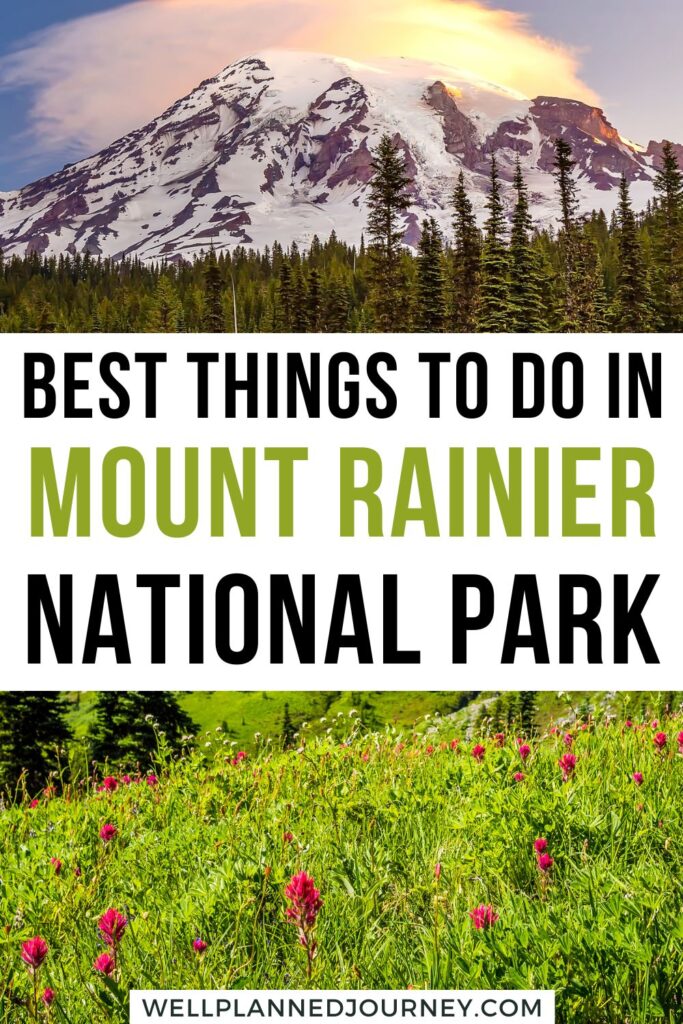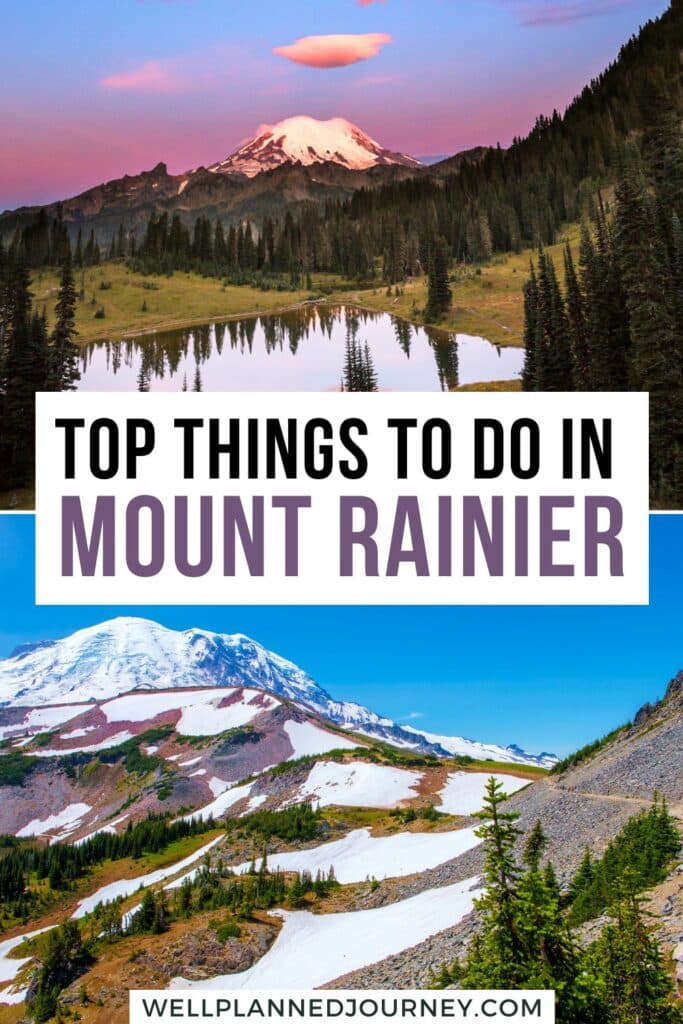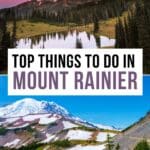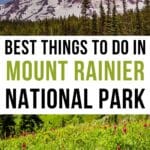Are you planning a Mount Rainier National Park trip but need help determining where to begin?
Mount Rainier National Park is home to the highest mountain in Washington state and the most glaciated peak in the Lower 48: its namesake Mount Rainier. The famed park is 60 miles southeast of Seattle and offers some of the best vistas and hikes in the Cascades.
But with so many impressive activities, how do you prioritize your time in this stunning national park?
This guide covers the best things to do in Mount Rainier National Park, including a sample itinerary! Plus, I’m sharing tips on how many days you need, when to visit, where to stay, and more.
This post may contain affiliate links, where I may receive a small commission at no additional cost to you. Read more in this disclosure policy.
Mount Rainier National Park At-A-Glance
Before diving in, here are a few highlights to help you plan your trip:
- Best Time to Visit: Late July to September is the best time to visit, once the snow has melted and all roads in the park have opened. Snow can stick around until mid-July each year.
- Where to Stay: Two lodges inside the park, Paradise Inn and National Park Inn, provide excellent access to the Paradise area. Outside the park, consider staying at Mountain Meadows Inn or Nisqually Lodge in Ashford, WA.
- How to Get There: The closest airport is in Seattle, 3 hours away. Use Expedia to browse flights and find the best price.
- How to Get Around: My favorite way to see Washington is by campervan. I had a fantastic experience renting a luxury campervan through Noma Vans on Outdoorsy. You can also quickly get around by car. I recommend using Expedia to browse for deals.
- Don’t Forget: Be sure to get an America the Beautiful National Park Pass ahead of time. This $80 pass is valid for 12 months and gets you into all 400+ national park sites (including all 3 Washington parks).
Overview of the Regions of Mount Rainier National Park
Before diving into the best things to do, it’s essential first to understand the layout of Mt Rainier National Park and discuss the five park regions.
Mount Rainier National Park has five main sections, starting on the northern side and moving clockwise:
- Sunrise: Located on the northeastern side of Mount Rainier, Sunrise is known for its stunning mountain views and challenging, high-elevation hiking trails. As the highest part of the park you can drive to, it offers a unique vantage point of the surrounding peaks.
- Ohanapecosh: In the southeastern part of the park, Ohanapecosh offers unique forests reminiscent of the Olympic Peninsula. Visitors can explore wooded trails, hot springs, and the Ohanapecosh Visitor Center.
- Paradise: As one of the most popular regions in Mount Rainier National Park, Paradise lives up to its name with its breathtaking scenery. It features lush meadows filled with wildflowers, stunning vistas of glaciers and waterfalls, and iconic trails like the Skyline Trail.
- Longmire: The historic district of Longmire, located in the southwestern part of the park, offers a glimpse into the park’s past. Visitors can explore the Longmire Museum and more leisurely scenic trails near the Nisqually Entrance.
- Carbon River / Mowich: On the northwest side of Mount Rainier, the Carbon River and Mowich region showcase a remote part of the park, requiring navigating a 20-mile unpaved road. Carbon River / Mowich is an excellent region for hiking and camping away from the crowds.
The two most popular areas of the park are Paradise, on the southern side of the mountain, and Sunrise, on the northeast side.
The Nisqually Entrance (closest to Paradise/Longmire) is open year-round. However, the White River Entrance (closest to Sunrise) only opens in the summer.
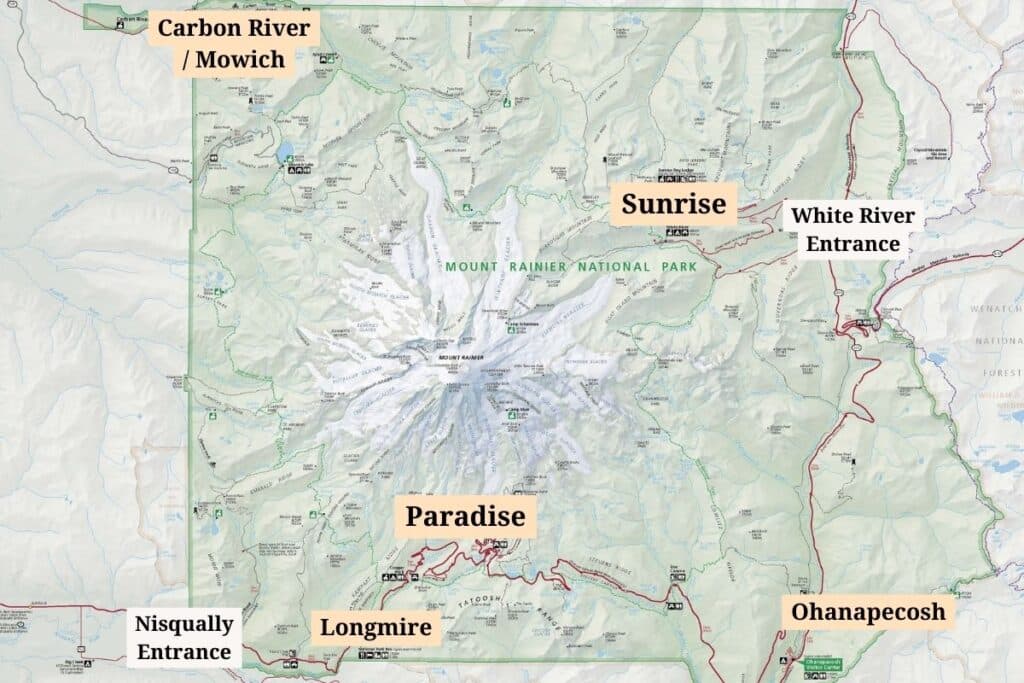
Tips for Visiting Mount Rainier National Park
- Get the America the Beautiful National Park Pass. If you plan on visiting other national parks in the next 12 months, you’ll save money with a national park pass. Get the America the Beautiful Pass for only $80.
- Start your day early. Crowds peak in July and August during Mount Rainier’s narrow peak season. Plan to arrive at areas like Paradise or Sunrise by 9 AM to avoid crowds and find parking.
- Check road and trail status before visiting. Mount Rainier gets lots of snow, so roads and trails can be closed well into the summer. The park regularly publishes closures and advisories for highways and hiking trails. Check the Mount Rainier NPS site for updates.
- Fill up on gas before entering the park. No gas stations are inside Mount Rainier National Park, so have a full tank before heading to the park for the day. If you’re heading to Paradise, the last gas station is in Ashford. If you’re heading to Sunrise, fill up on gas in Enumclaw.
- Cell service is limited inside the park. Be sure to download Google Maps offline on your phone before entering the park and pick up a physical map at the entrance station on your way into the park.
- Pack the essentials. Prepare a daypack with water, snacks, sunscreen, insect repellent, a map or guidebook, and comfortable footwear. Mount Rainier’s weather conditions can be unpredictable, so it’s essential to be prepared for changing conditions. Dress in layers, and be sure to bring a fleece pullover and a rain jacket.
- Stay on the trail. Keeping on the path helps preserve the park’s delicate ecosystems and wildlife habits. This rule is even more crucial in the early summer months when trails are still snow-covered as you risk unexpected water crossings and entering avalanche zones.
Looking for more tips on what to pack for your trip? Check out my guides on the best hiking gear, what to pack for a road trip, and essential camping gear for all my favorite gear picks and tips to make packing for your trip a breeze!
Best Things to Do in Mount Rainier National Park
Mount Rainier National Park has excellent activities for every traveler, from hikers to road trippers. This section covers the 25 best things to do in Mount Rainier National Park: hikes, scenic drives, and scenic viewpoints!
Are you planning a national park trip but don’t know where to start? Get my free 28-page national park ebook where I break down everything you need to know to visit all 63 USA national parks.
Download your free ebook here.
1. Skyline Trail
- Distance: 5.6 miles
- Elevation Gain: 1,771 feet
- Difficulty: Moderate
- Time to Hike: 3-5 hours
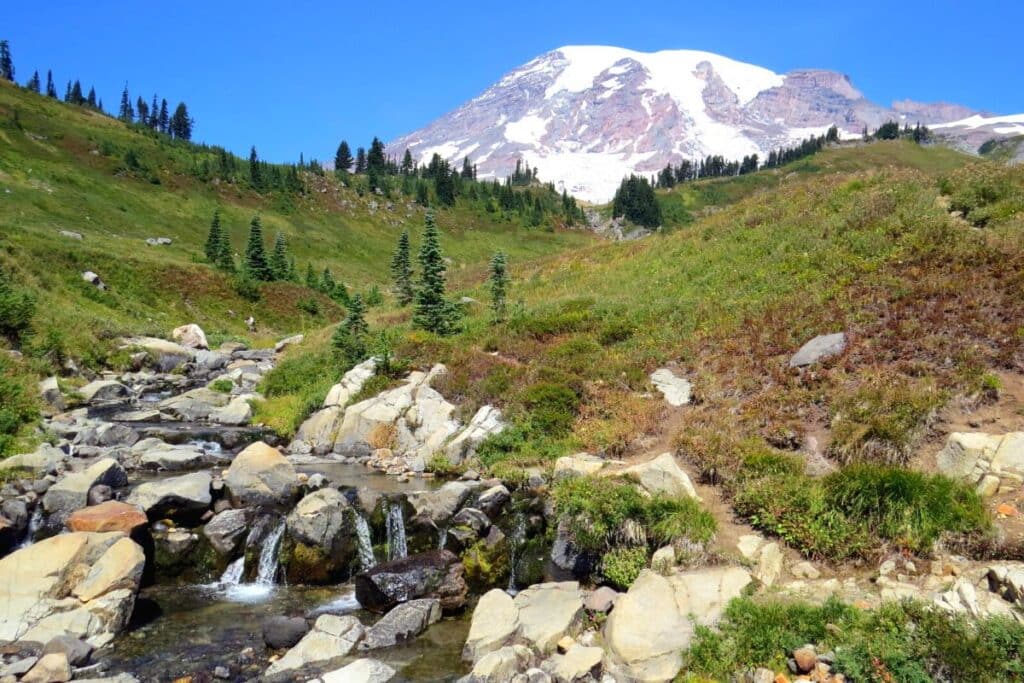
The Skyline Trail is Mount Rainier National Park’s most popular (and most scenic!) hike. If you only have time for one thing in Mount Rainier, don’t miss the Skyline Trail!
The nearly 6-mile hike starts at the Henry M. Jackson Memorial Visitor Center near Paradise Inn. The ultra-scenic loop is best hiked from late July to early September when the snow has melted and wildflowers are in full bloom.
You’ll hike clockwise, passing Glacier Vista to Panorama Point. From Panorama Point, you’re greeted with spectacular views of Mount Rainier plus the Paradise Valley below.
On a clear day, you can see Mount St. Helens, Mount Adams, and Mount Hood!
The loop continues in a clockwise direction. Don’t miss a stop at Myrtle Falls, a stunning 72-foot waterfall featuring views of Mount Rainier in the background.
2. Reflection Lakes
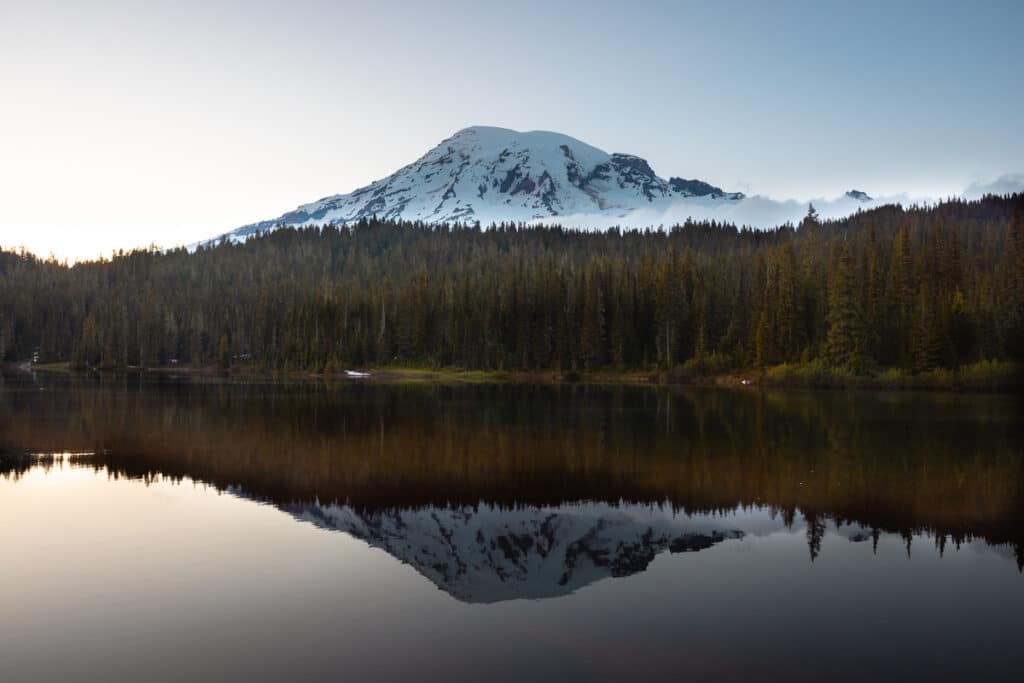
Reflection Lakes is an incredibly picturesque spot that offers unobstructed views of Mount Rainier. The still lake waters reflect the towering Mount Rainier, making this an excellent sunrise or sunset photography spot.
Best of all, Reflection Lakes is accessible for all visitors, located directly off of Stevens Canyon Road, only a 10-minute drive from Paradise!
In the summer, wildflowers scatter the lake shore. In the fall, the surrounding trees turn an orange-red hue, making for excellent photography.
3. Narada Falls
- Distance: 0.2 miles
- Elevation Gain: 59 feet
- Difficulty: Easy
- Time to Hike: 15 minutes
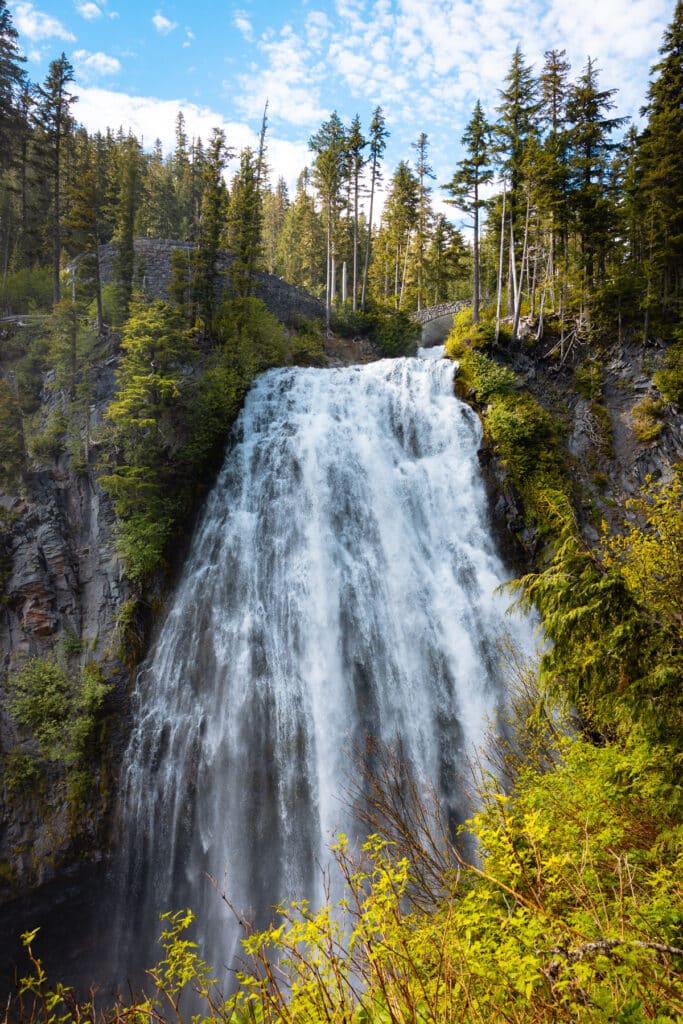
Narada Falls is an easy side trip off Paradise Valley Road. The towering two-tier waterfall tumbles 168 feet into a pool below. It’s one of the tallest waterfalls in Mount Rainier National Park!
The trek down to a viewpoint of the falls is only 0.2 miles roundtrip, making it one of the most accessible (and most stunning!) waterfalls in the park!
4. Grove of the Patriarchs
- Distance: 1.1 miles
- Elevation Gain: 52 feet
- Difficulty: Easy
- Time to Hike: 30 minutes

The star of Ohanapecosh near the Stevens Canyon Entrance, the Grove of the Patriarchs Trail is a must-see! This easy 1-mile hike features an old-growth forest filled with giant Douglas firs, western red cedars, and western hemlock trees along the peaceful Ohanapecosh River.
The ancient trees here are reminiscent of Olympic National Park’s forests and protect ancient trees over 1,000 years old!
Important Note: The Grove of the Patriarchs Trail has been closed since late 2021 due to flood damage. Instead of hiking the Grove of the Patriarchs, I recommend the Silver Falls Loop. This nearby 2.9-mile loop trail is equally stunning and features an incredible icy-blue 40-foot waterfall.
5. Mount Fremont Lookout
- Distance: 5.6 miles
- Elevation Gain: 1,108 feet
- Difficulty: Moderate
- Time to Hike: 3 to 4 hours
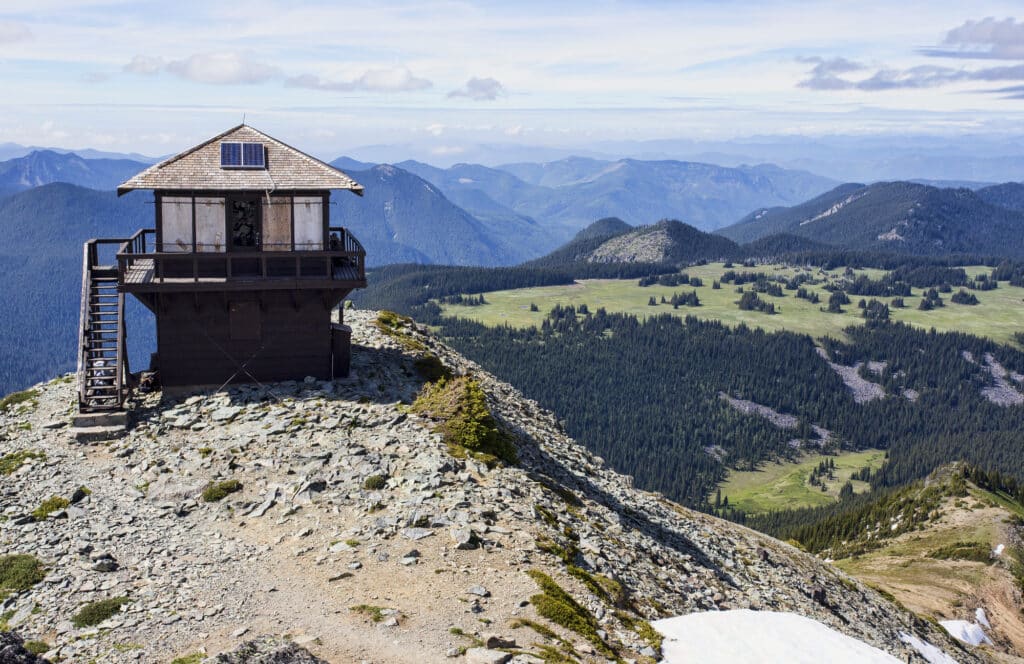
The Mount Fremont Lookout Trail is one of the best hikes in the Sunrise region of Mount Rainier National Park. This 5.6-mile out-and-back trail takes you to an iconic fire lookout perched on a ridge, providing panoramic views of Mount Rainier and the surrounding valleys and mountain ranges.
Starting from the Sunrise Visitor Center, you’ll climb the gradual ascent along the Sourdough Ridge Trail. About 1.5 miles into the hike, you’ll reach Frozen Lake, where the path diverges to Mount Fremont Lookout.
This lookout was built in 1934 to watch over the surrounding forests for wildfires. Today, the fire lookout offers excellent views of Mount Rainier, the Cascades, and even the Olympic Mountains!
The incredible views make the Mount Fremont Lookout Trail an excellent spot for sunrise and sunset!
6. See the Wildflowers
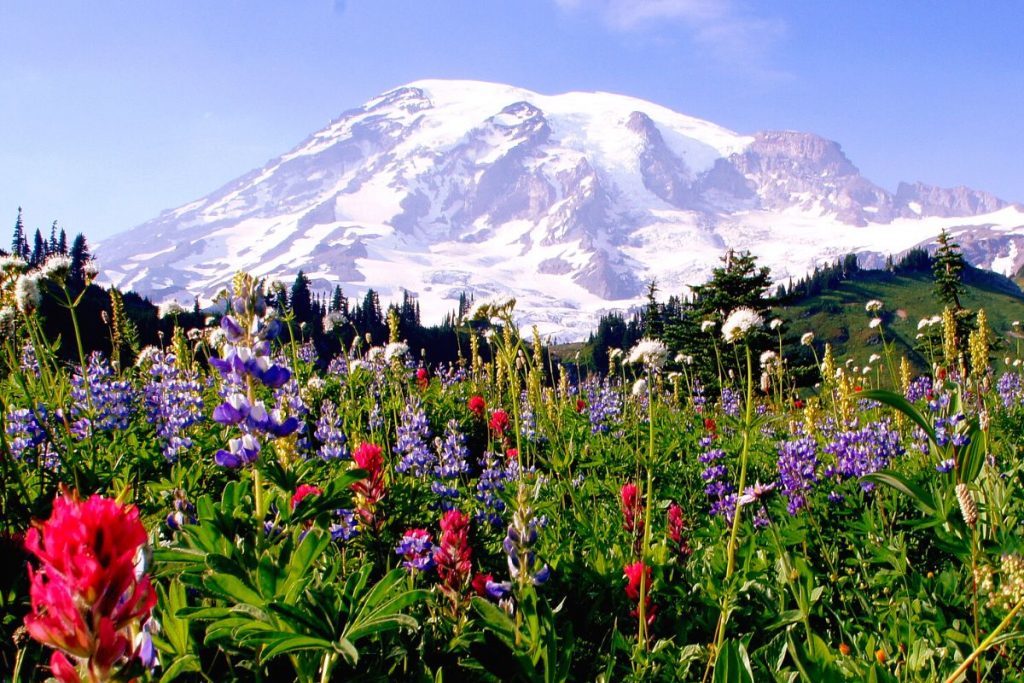
Spotting wildflowers is one of the best things to do in Mount Rainier in late summer. Tiny, colorful displays cover the alpine meadows throughout the park from late July to mid-August.
Hundreds of wildflower varieties are found inside the park, ranging from bright pinks and purples to warm yellows and reds.
If you’re interested in seeing the best wildflower displays in Mount Rainier, check out some of these spots:
- Skyline Trail in the Paradise region
- Alta Vista Trail in the Paradise region
- Berkeley Park in the Sunrise region
- Pinnacle Peak in the Paradise region
- Van Trump Park in the Paradise region
- Spray Park in the Mowich Lake region
7. Myrtle Falls
- Distance: 0.7 miles
- Elevation Gain: 154 feet
- Difficulty: Moderate
- Time to Hike: 30 minutes

Myrtle Falls is one of the most iconic waterfalls in Mount Rainier National Park. The cascade is located along the Skyline Trail loop, about a half mile from the parking area.
The short distance to the falls makes it a more accessible hike option for those not interested in the full Skyline loop.
The waterfall tumbles 72 feet into a gorge with the stunning Mount Rainier as the backdrop. Myrtle Falls has several incredible viewpoints, so spend time exploring the area to find your favorite vantage point.
8. Paradise Inn
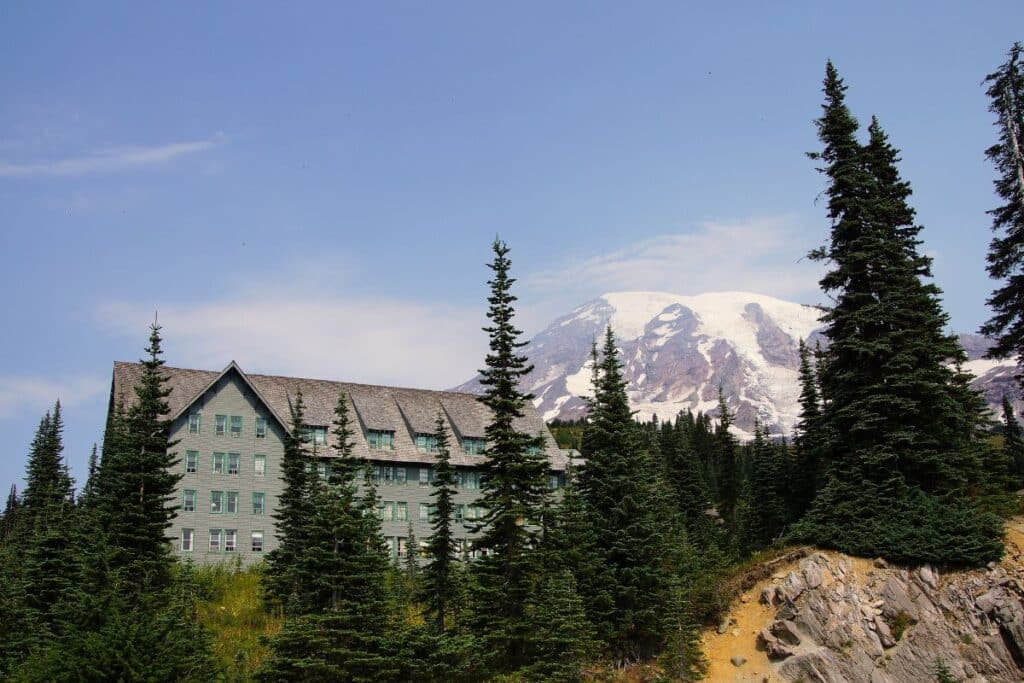
The Paradise Inn is one of two lodges in Mount Rainier National Park. Originally built in 1916, Paradise Inn is listed on the National Register of Historic Places.
Staying here provides unparalleled access to the Paradise region, only steps to the visitor center and trailheads for the Skyline Trail, Nisqually Vista, and Myrtle Falls.
But even if you aren’t staying at the Paradise Inn, it’s still worth exploring! The inn offers a gift shop, a cozy lobby with a stone fireplace, an onsite restaurant, and a porch with great views for relaxing after a hike.
9. Sunrise Point
As you enter the Sunrise region of Mount Rainier National Park, you’ll wind for miles up Sunrise Park Road. One of the best viewpoints along this route is Sunrise Point.
This spot is on one of the final switchbacks before arriving at the Sunrise Visitor Center and parking area.
This viewpoint has abundant parking and offers incredible views of Mount Rainier and other distant peaks like Mount Adams, the second-highest peak in Washington.
10. Burroughs Mountain Trail
- Distance: 9.5 miles
- Elevation Gain: 2,601 feet
- Difficulty: Strenuous
- Time to Hike: 6 to 8 hours
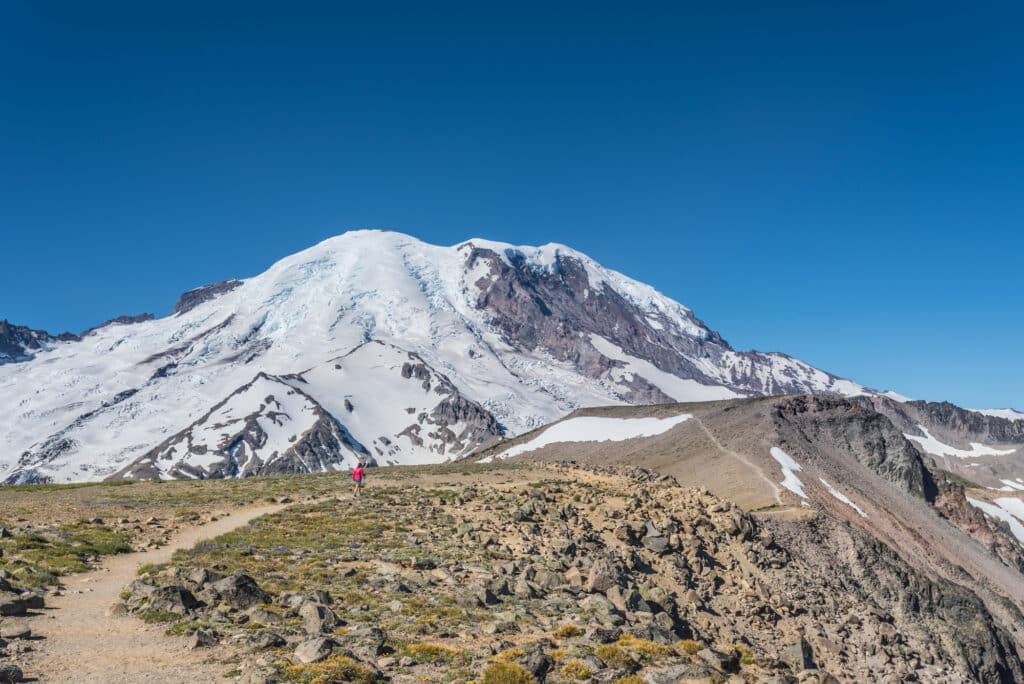
The Burroughs Mountain Trail is a challenging hike that provides excellent, up-close views of Mount Rainier. At nearly 10 miles, the trek takes you to three spectacular viewpoints: First Burrough, Second Burrough, and Third Burrough.
The trail takes you across rocky terrain and open meadows, immersing you in the rugged beauty of the alpine landscape. The long day hike starts at the Sunrise Visitor Center and initially follows the Sourdough Ridge Trail to Frozen Lake.
From there, you’ll continue to the First Burrough. The Second Burrough offers panoramic views of the Sunrise region and Mount Rainier.
The final viewpoint, the Third Burrough, offers the closest views of the mountain along the northeastern side of Mount Rainier but requires navigating an unmaintained trail through barren, rocky terrain.
You’ll then turn back to the right at the Sunrise Trail Junction to stay on the Burroughs Mountain Trail and complete the loop trail. On the way back to the visitor center, you’ll connect with the Wonderland Trail at the backcountry Sunrise Camp.
11. Sourdough Ridge Trail
- Distance: 2.8 miles
- Elevation Gain: 534 feet
- Difficulty: Easy
- Time to Hike: 2 hours
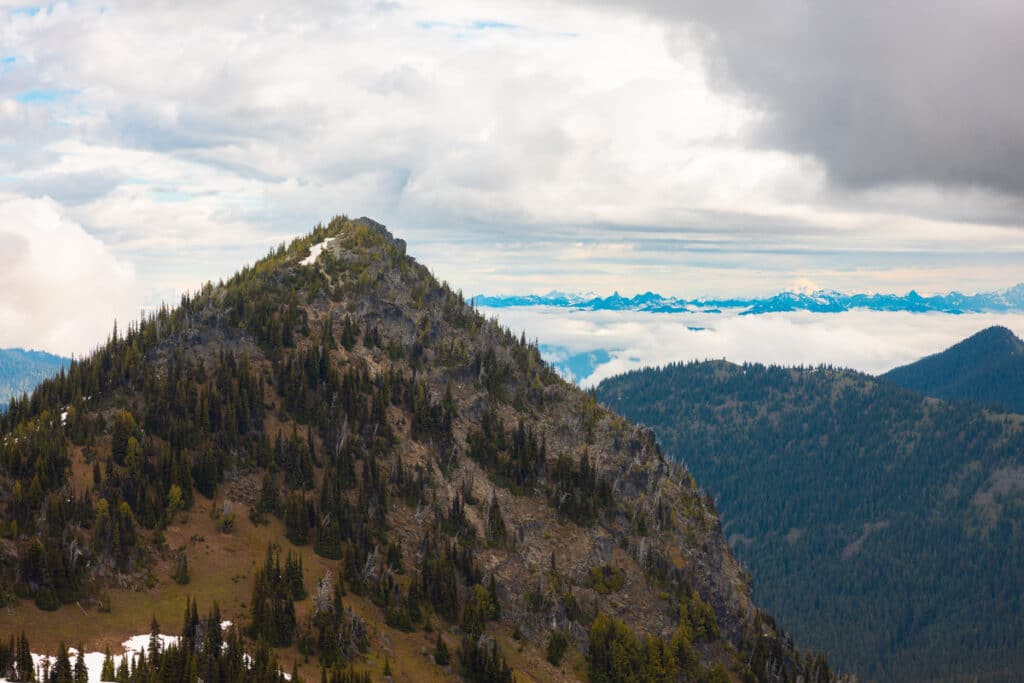
One of the best easy hikes in the Sunrise region, the Sourdough Ridge Trail is the perfect, less strenuous alternative to the Mount Fremont Lookout or Burroughs Mountain Trail. The trail starts at the Sunrise Visitor Center, taking you to incredible viewpoints along the ridgeline.
From Sourdough Ridge, you’re greeted with excellent views of distant mountain peaks to the north, the Sunrise region, and Mount Rainier!
12. Tipsoo Lake
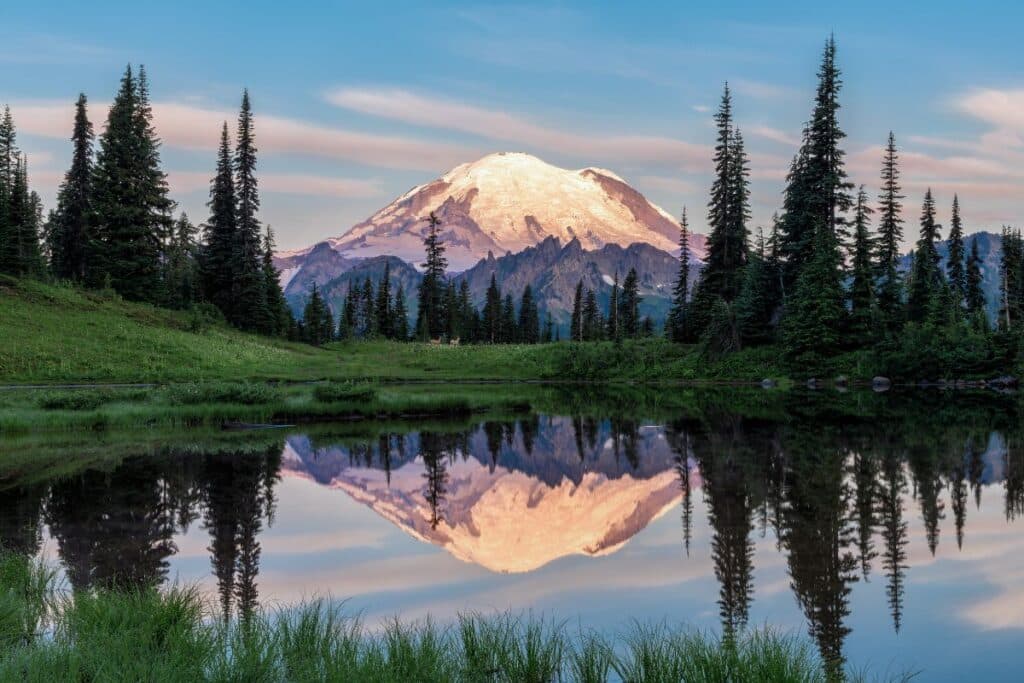
Tipsoo Lake is a serene alpine lake along one of the best scenic drives in Mount Rainier National Park, the Chinook Scenic Byway. This route at Chinook Pass is only open seasonally due to heavy snowfall.
But from late July through September, you can explore the scenic lakeside, with wildflower-filled meadows and incredible reflections of Mount Rainier towering in the distance.
It’s easiest to stop and see Tipsoo Lake on a drive from Paradise to Sunrise or while hiking the Naches Peak Loop.
13. Naches Peak Loop
- Distance: 3.5 miles
- Elevation Gain: 659 feet
- Difficulty: Moderate
- Time to Hike: 2 to 3 hours

The Naches Peak Loop is a moderate 3.5-mile hike with great wildflower-filled alpine meadows. The trail follows a portion of the Pacific Crest Trail, first taking you past Tipsoo Lake before ascending to the trail’s summit, around 600 feet.
If you have some extra time in Mount Rainier, this hike is well worth it for the incredible views of Mount Rainier and its many surrounding valleys. For the best views of Mount Rainier as you go, hike the trail clockwise.
14. Tolmie Peak Fire Lookout
- Distance: 5.6 miles
- Elevation Gain: 1,555 feet
- Difficulty: Moderate
- Time to Hike: 3 to 5 hours
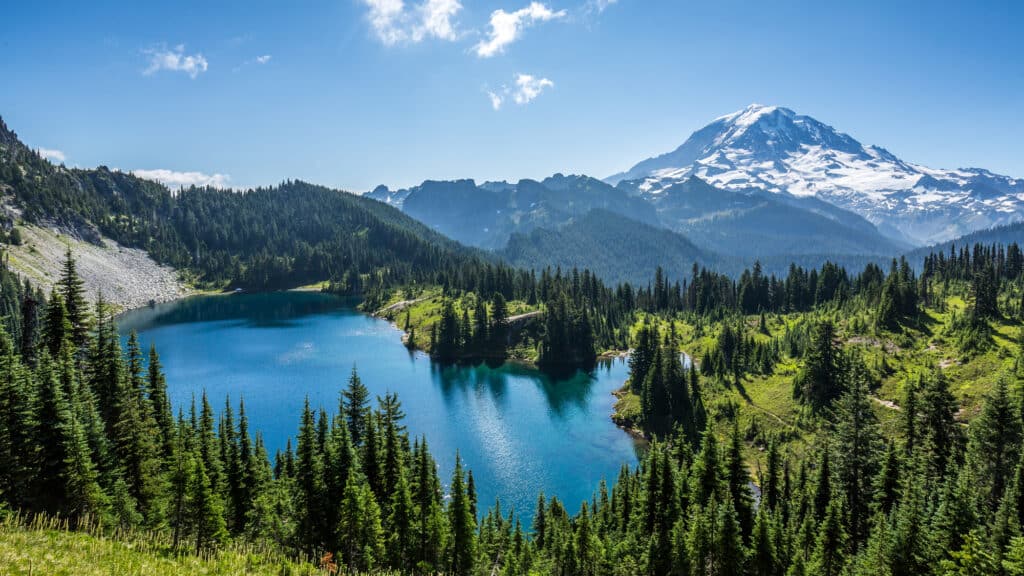
Another classic fire lookout in Mount Rainier National Park, the Tolmie Peak Fire Lookout Trail, is a less crowded and just as scenic alternative to the Mount Fremont Lookout Trail.
The trail is located in the less visited and harder-to-reach region of Mowich Lake, which requires navigating an unpaved road.
The trail starts in the forests surrounding Mowich Lake before ascending to Ipsut Pass and Eunice Lake before ending at the lookout. The hike is gorgeous in the early fall, when leaves change to orange and red hues.
Side note – this trail is known for having tons of mosquitos, so don’t forget to pack bug spray!
15. Spot Wildlife
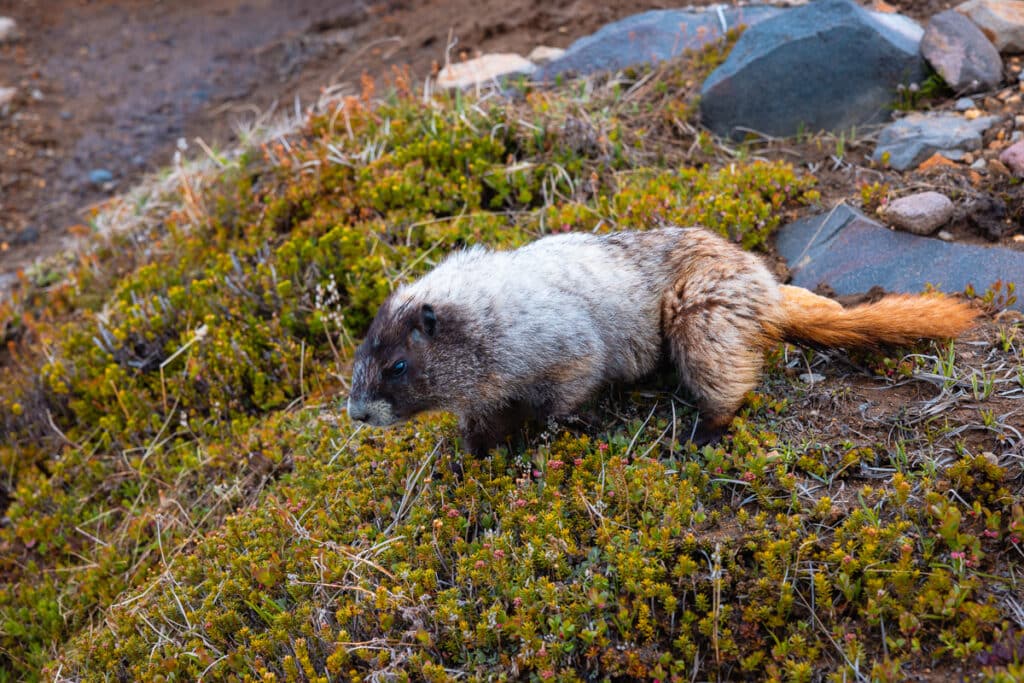
Mount Rainier National Park is home to several beautiful wildlife species. One of the best ways to see wildlife is to get off the road and onto the trail! Consider hiking the Skyline Trail in Paradise or the Burroughs Mountain Trail in Sunrise for the best wildlife-spotting opportunities!
These are just some of the incredible animals you can expect to find around Mount Rainier:
- Mountain goats
- Marmots
- Black bears
- Elk
- Black-tailed deer
16. Bench and Snow Lakes Trail
- Distance: 2.2 miles
- Elevation Gain: 449 feet
- Difficulty: Moderate
- Time to Hike: One hour
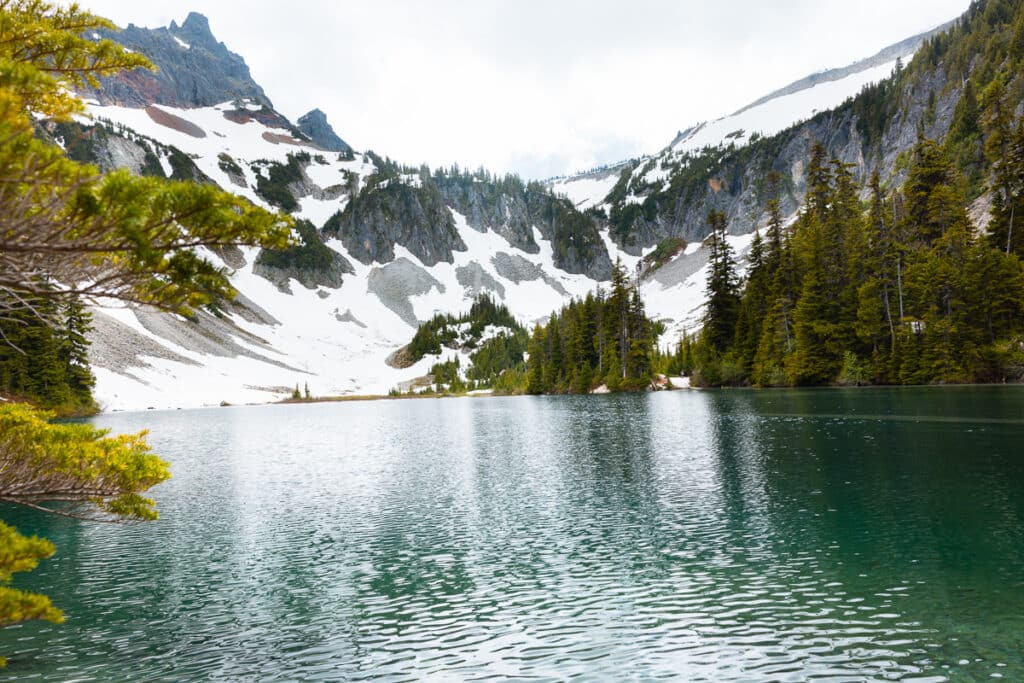
Located along Stevens Canyon Road, the Bench and Snow Lakes Trail takes you on a short, moderate hike to two subalpine lakes. After a short hike through an old-growth forest and alpine meadow, you’ll reach Bench Lake, best seen from a vantage point above.
After taking in the mountain views, continue along the trail to Snow Lake. Towering mountains with spectacular views surround this icy blue glacial lake.
Be sure to see the lake from the backcountry Snow Camp and the trail on the west side of the lake.
17. Silver Falls Trail
- Distance: 2.9 miles
- Elevation Gain: 521 feet
- Difficulty: Easy
- Time to Hike: 2 hours

The Silver Falls Trail is a scenic hike in the old-growth forests of Ohanapecosh, known for its stunning icy-blue 75-foot waterfall.
The trail starts in the Ohanapecosh Campground and climbs rolling hills in a dense, ancient woodland along the Ohanapecosh River.
About halfway through the hike, you’ll come across Silver Falls, seen from several vantage points, including a bridge crossing the rushing river through a mossy gorge.
18. Christine Falls
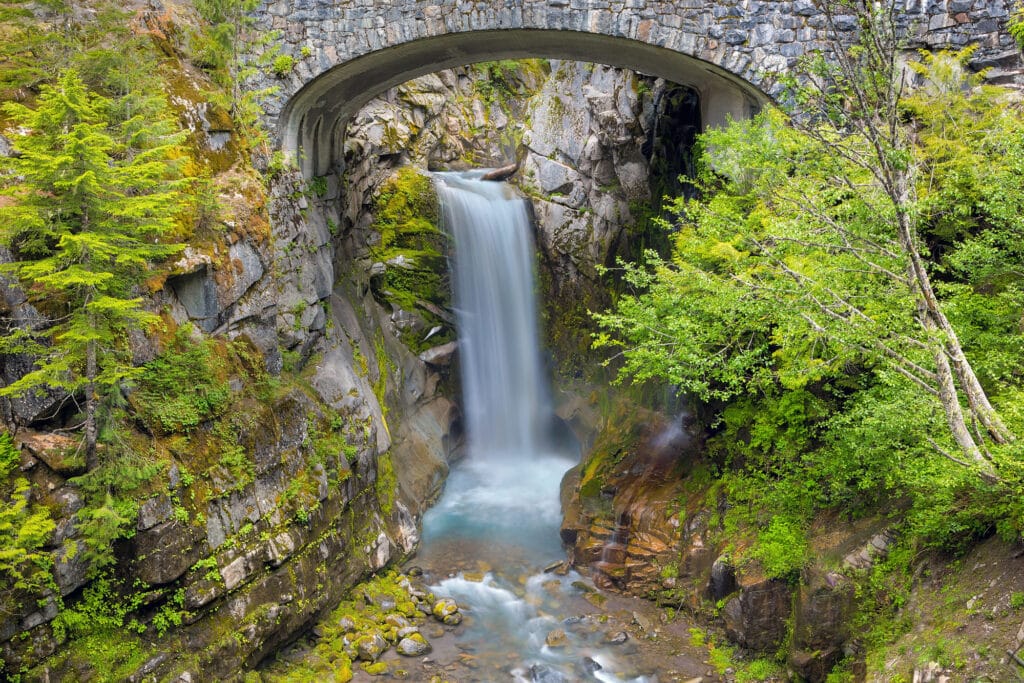
Christine Falls is another scenic roadside destination, a beautiful 69-foot waterfall framed by an arched stone bridge. The waterfall plunges into a small pool below the bridge, surrounded by lush greenery and moss-covered rocks.
The best way to see the waterfall is by parking at the pull-outs on either side of the bridge and walking below Christine Falls Bridge.
19. Longmire
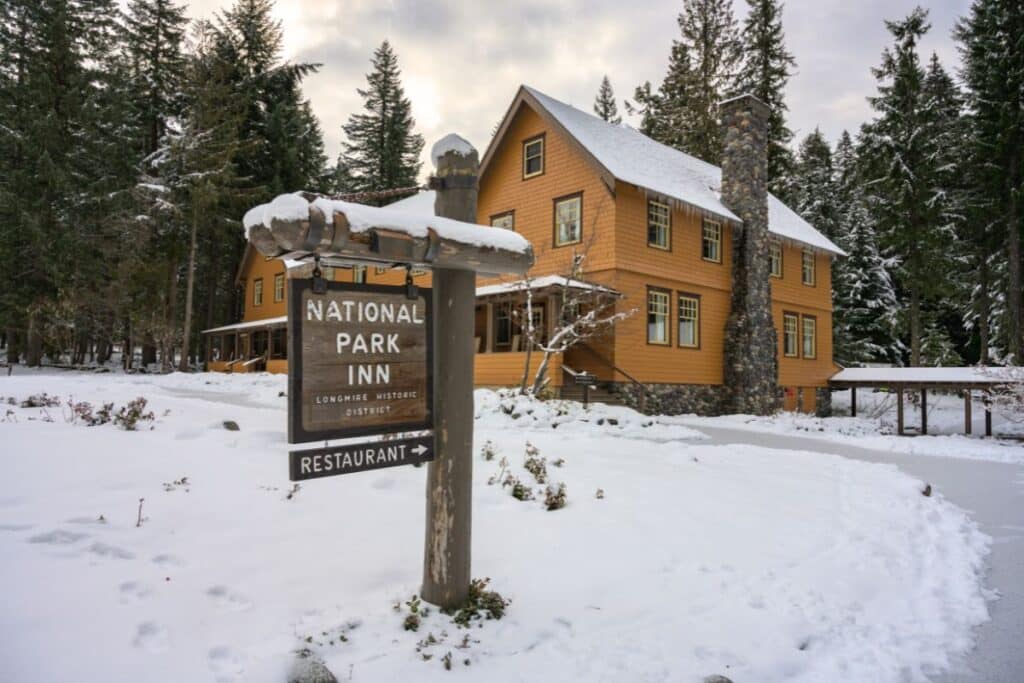
Years ago, when Mount Rainier became a national park, Longmire was the gateway to the park and home to the park headquarters. Today, Longmire is a National Historic District and home to a museum and lodge near the Nisqually Entrance.
If you have extra time in Mount Rainier National Park, check out the Longmire Museum, the National Park Inn, and the old-growth, mossy forests on the Trail of the Shadows.
20. Stargazing
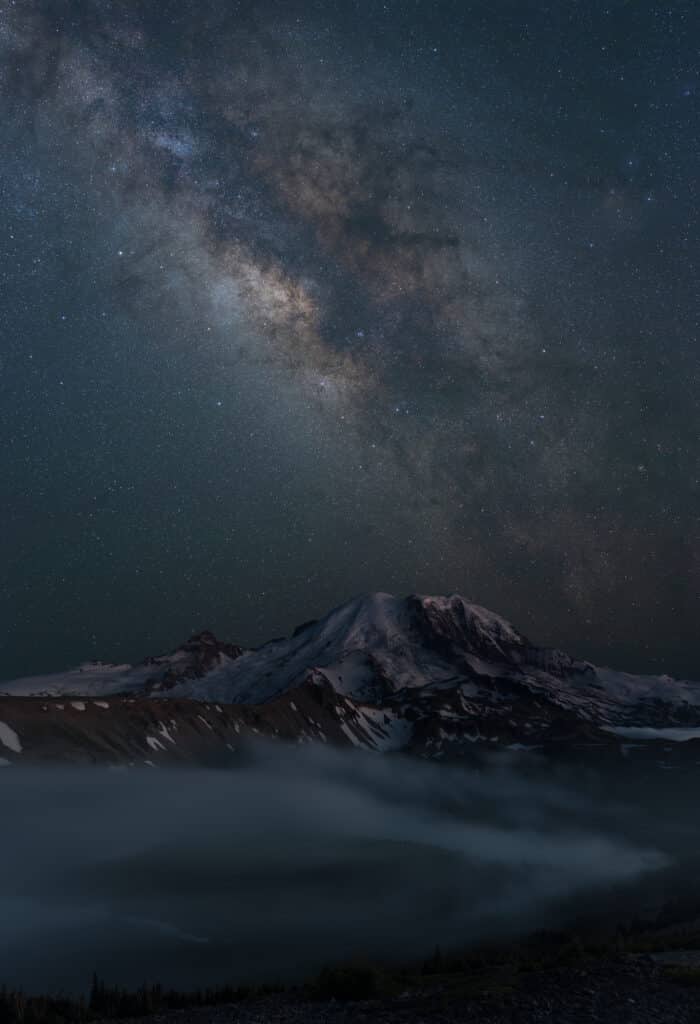
Located several hours from any major city, Mount Rainier can be a great place to stargaze and photograph the night sky. While not dark enough to earn the designation of an International Dark Sky Park, there are still many stars visible here.
The Sunrise area is one of the best places to stargaze in the park. You can photograph the Milky Way and Mount Rainier in the summer!
If you’re interested in a guided experience, consider joining one of the ranger-led stargazing programs.
21. Ricksecker Point
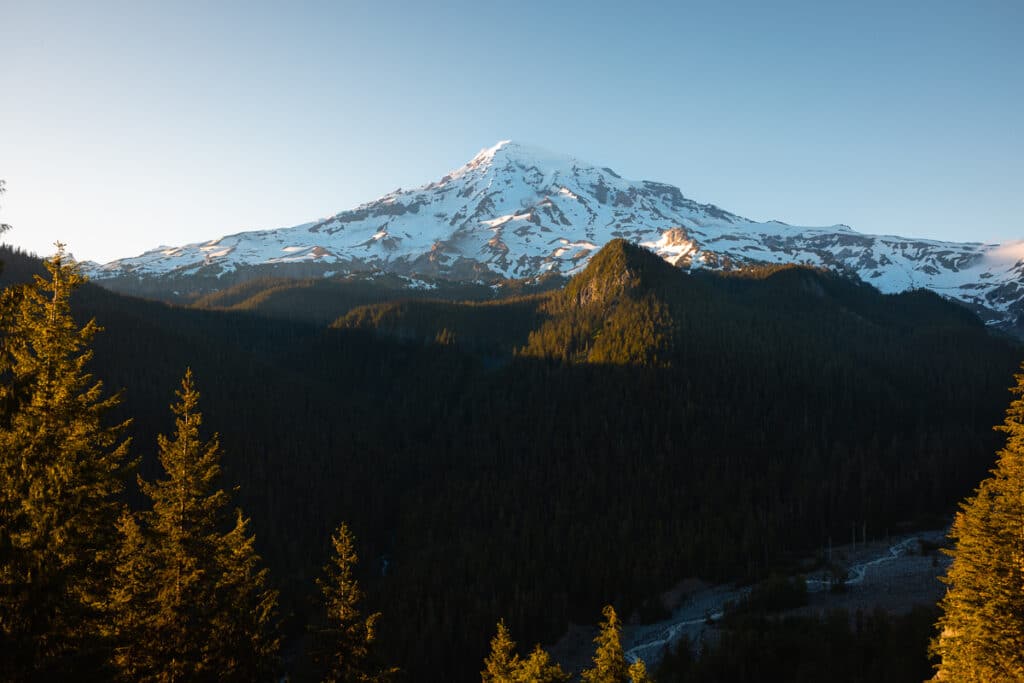
Ricksecker Point provides one of the best views of Mount Rainier in Paradise. The quick detour takes you on a short loop drive along Ricksecker Point Road. You’re greeted with expansive views of Mount Rainier.
This viewpoint is an excellent spot for early morning and sunset photography!
22. Sunrise Nature Trail
- Distance: 1.5 miles
- Elevation Gain: 370 feet
- Difficulty: Moderate
- Time to Hike: 1 hour
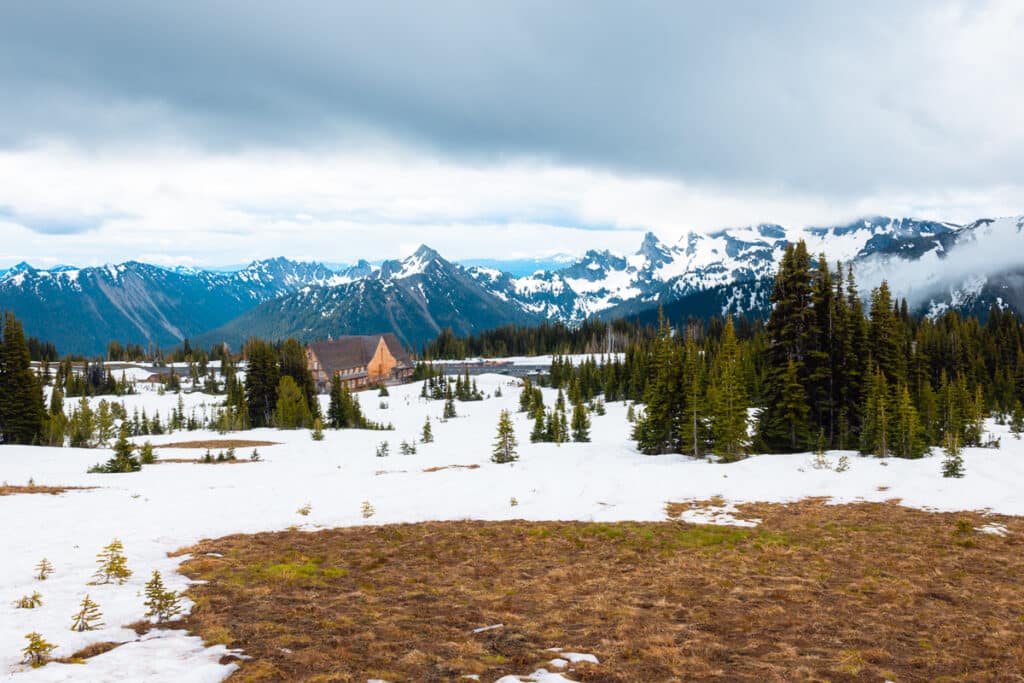
If you’re looking for a shorter hike with great views of Mount Rainier, don’t miss the Sunrise Nature Trail. This hike starts behind the Sunrise Day Lodge. It winds through scenic alpine meadows with excellent views of Mount Rainier above.
The Sunrise Nature Trail is a beautiful hike in the early morning or at sunset, especially during the wildflower season.
23. Nisqually Vista Loop
- Distance: 1.1 miles
- Elevation Gain: 180 feet
- Difficulty: Easy
- Time to Hike: 30 minutes to 1 hour
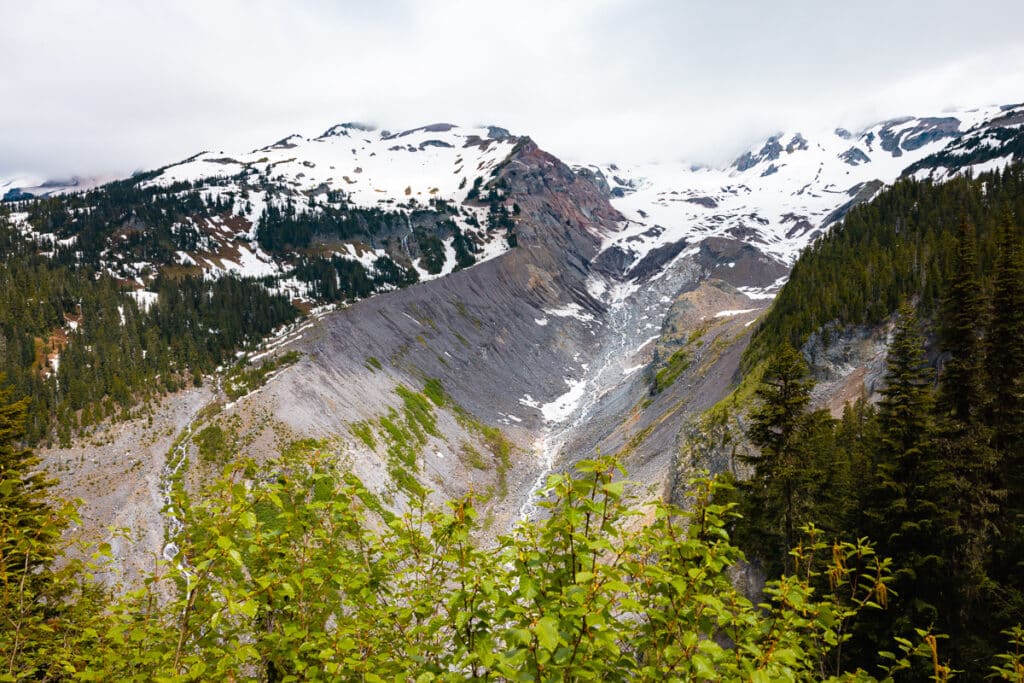
The Nisqually Vista Trail is another easy hike with excellent views of Mount Rainier and its many glaciers. The short loop starts a short walk from the Paradise parking lot and winds through small forests and meadows.
The loop provides one of its best views at Nisqually Vista, where you can catch views of one of Rainier’s largest glaciers, the Nisqually Glacier.
24. Wonderland Trail
- Distance: 93 miles
- Elevation Gain: 25,000 feet
- Difficulty: Strenuous
- Time to Hike: 5 to 13 days
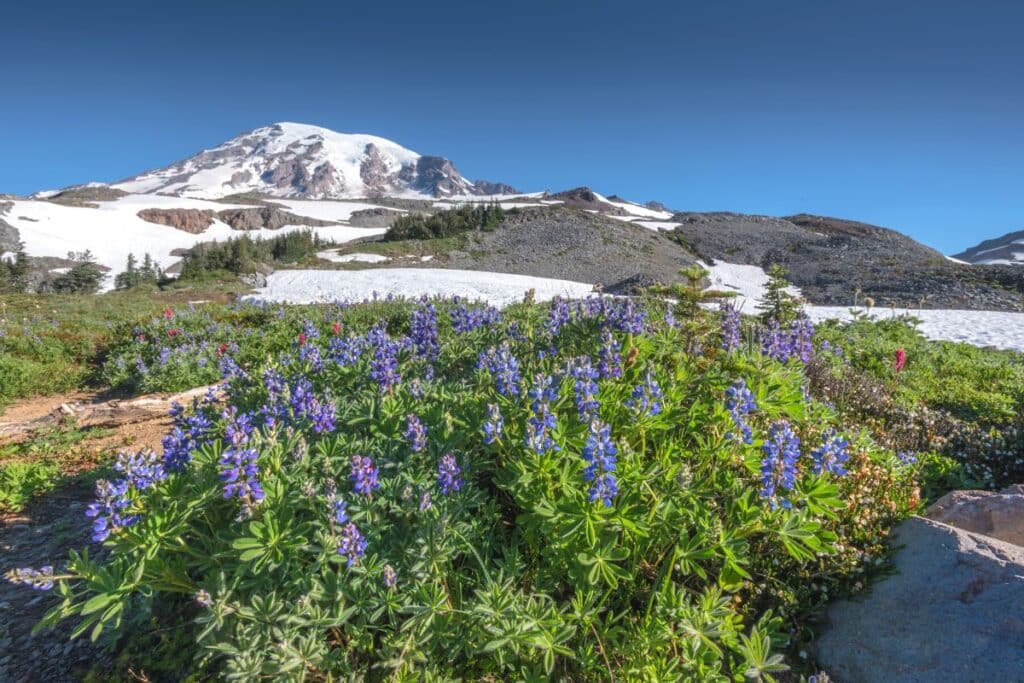
The Wonderland Trail is the ultimate Mount Rainier experience. The multi-day backpacking trail makes a full loop around the base of Mount Rainier, providing excellent views the entire day.
If you’re interested in escaping into the backcountry, this is one of the best places in the United States!
The trail guides you through temperate forests, canyons, rivers, and alpine landscapes on a journey in about one week. You’ll need to get a backcountry permit in advance to hike the Wonderland Trail.
25. Summit Mount Rainier
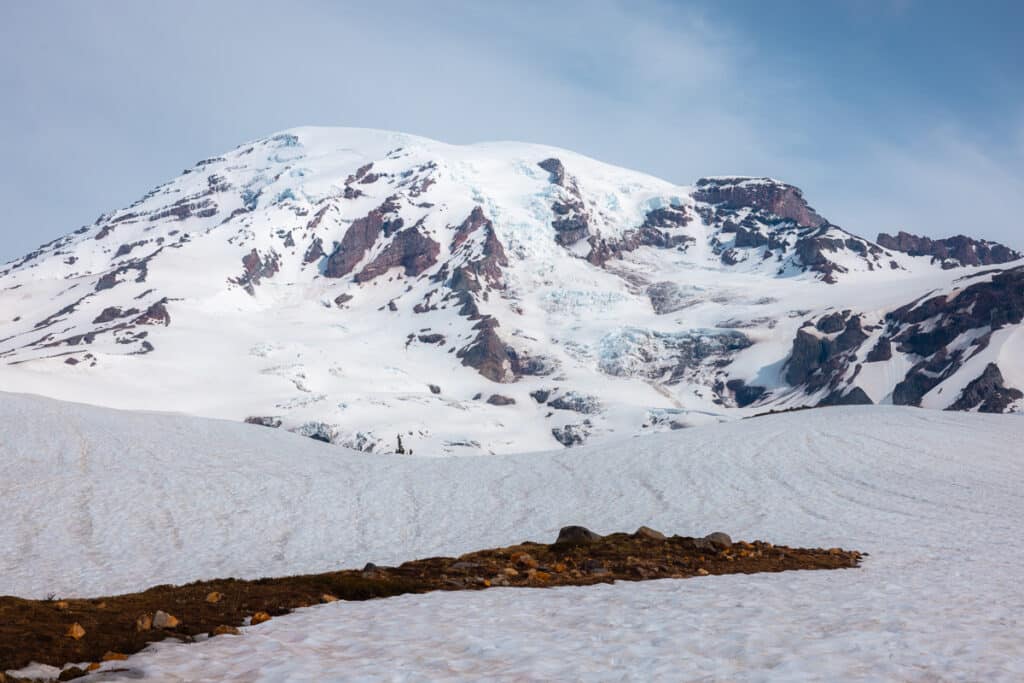
Reaching Mount Rainier’s summit is the ultimate adventure-seekers activity in Mount Rainier National Park. Reaching the summit requires intense mountaineering experience climbing the glaciated peaks.
Hikers start at the Paradise parking area before ascending to Camp Muir (named for John Muir) to spend the night. Early the next day, the climb to the summit begins before descending back to Paradise.
This adventure typically takes two to three days and is often done on a guided tour. You’ll need the right equipment, technical knowledge, and a climbing permit. Very few visitors to Mount Rainier choose to conquer the summit.
How Many Days Do You Need in Mount Rainier National Park?
While you can see the highlights of Mount Rainier in one day, you’ll get the best experience by spending two to three days in the park. With two or more days, you can do several hikes and visit both the Sunrise and Paradise regions.
Sample Mount Rainier National Park Itinerary
If you’re looking for ideas on how to check off these incredible things best to do, consider one of these sample itineraries, depending on how much time you have.
If you only have one day, spend your time exploring Paradise:
- Hike the Skyline Trail, including stops at Panorama Point and Myrtle Falls
- Stop in at the Paradise Inn
- See Reflection Lakes
- Hike the Bench and Snow Lakes Trail
- Hike the Grove of the Patriarchs or Silver Falls Trail
- See Narada Falls, Ricksecker Point, and Christine Falls
Read More: Ultimate One Day Mount Rainier Itinerary
If you have two days, visit Sunrise. Explore these spots in addition to the one-day Paradise itinerary above:
- See Sunrise Point
- Pick one hike in the Sunrise region: Mount Fremont Lookout, Burroughs Mountain Trail, Sourdough Ridge Trail, or the Sunrise Nature Trail.
- Visit Tipsoo Lake
- Hike the Naches Peak Trail, with a stop at Tipsoo Lake
If you have three days, you’ll have more time to spend in Mount Rainier and can see nearly all of these top attractions:
- Day 1: Skyline Trail (including Panorama Point and Myrtle Falls), Nisqually Vista Loop, Narada Falls, Ricksecker Point, Christine Falls, Longmire, and the Trail of the Shadows
- Day 2: Reflection Lakes, Bench and Snow Lakes Trail, Grove of the Patriarchs, Silver Falls Trail, Naches Peak Trail (including Tipsoo Lake)
- Day 3: Sunrise Point, Mount Fremont Lookout + Burroughs Mountain Loop (if you’re up for it!)
Best Time to Visit Mount Rainier National Park
Picking the right time to visit Mount Rainier is crucial. With much of the park getting heavy snowfall, the window to see the park without snow on the ground is incredibly narrow.
I recommend visiting from mid-July to mid-September. Visiting before mid-July could mean trails are still snow-covered, and some parks roads are still partially closed.
To avoid crowds, consider visiting the week after Labor Day when the weather is still excellent, but crowds are fewer.
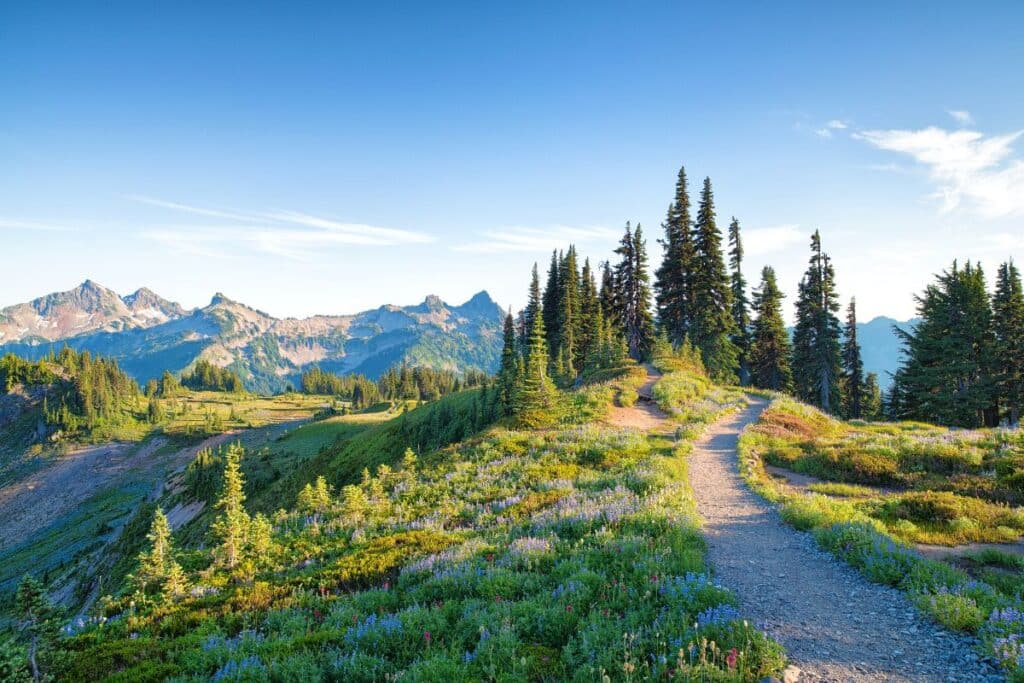
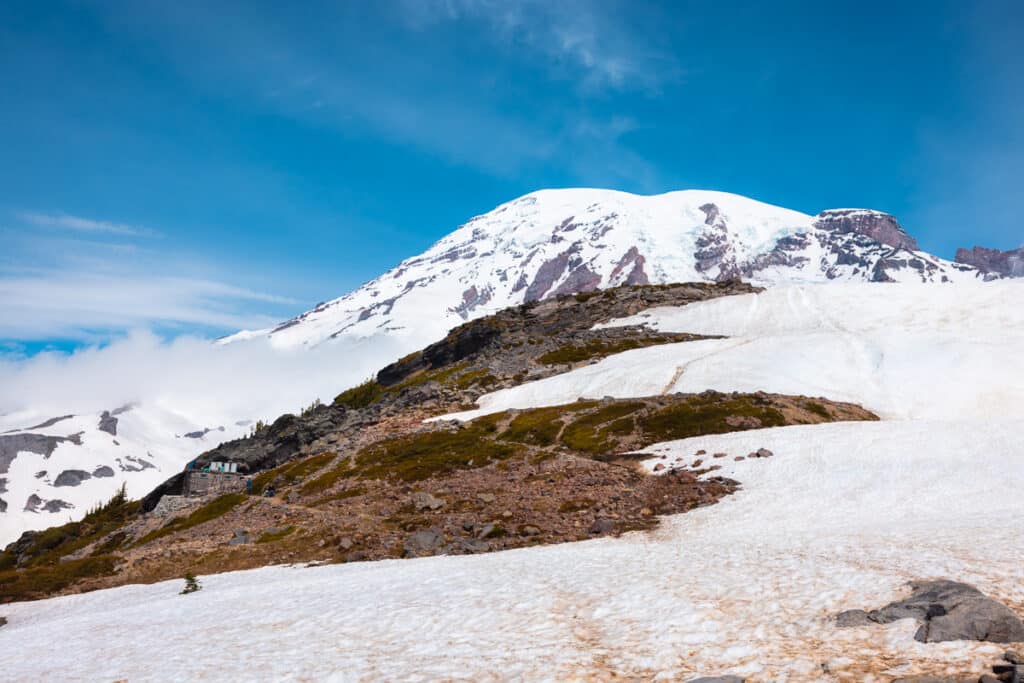
Here’s a breakdown of what to expect during each season in Mount Rainier:
- Summer: Summer is the most popular time to visit Mount Rainier National Park, so expect plenty of crowds. The weather is generally mild and pleasant, with temperatures ranging from 60°F to 80°F during the day. However, snow remains on the ground through the end of June, sometimes even early July. To hike snow-free trails and see the wildflowers in bloom, visit from mid-July through August.
- Fall: Starting in September, the foliage transforms into shades of gold, orange, and red, creating a picturesque landscape. The weather starts to cool, with temperatures ranging from 40°F to 70°F. Fall offers a quieter and less crowded experience compared to summer. Many hiking trails remain open, and you can enjoy the stunning scenery without the peak season crowds.
- Winter: The park receives heavy snowfall, and many roads and facilities close during this time. However, if you enjoy winter sports such as snowshoeing or skiing, Mount Rainier offers excellent opportunities for outdoor winter activities.
- Spring: The snow begins to melt, but much of the park, particularly in Paradise and Sunrise, remains snow-covered through the Spring into Summer. Weather is unpredictable, with frequent last season snow storms and road closures. It’s essential to check road and trail conditions before planning a visit in the spring. The temperatures can vary from 30°F to 60°F, so dress in layers for cooler temperatures.
Before planning your trip, check the park’s official website for the most up-to-date information on road and trail conditions, weather forecasts, and any closures or restrictions.
Where to Stay Near Mount Rainier National Park
There are several options for accommodations both inside and outside the park. Staying inside the park minimizes your drive time, but options are expensive and require further advance booking.
Staying outside the park is more budget-friendly, but you should still plan to book hotels several months in advance.
This interactive map can help you search all the available hotels and rental properties near Mount Rainier National Park! Simply scroll and click the map below to see what is available!
There are two lodges inside Mount Rainier National Park:
- Paradise Inn is a more luxurious inn in the heart of the Paradise region with views of Mount Rainier. Guests can enjoy unparalleled access to everything in the Paradise area, plus an on-site restaurant, bar, and coffee shop.
- National Park Inn is a no-frills lodge inside the park in the Longmire area, closest to Paradise. There’s also an on-site restaurant for guests to enjoy.
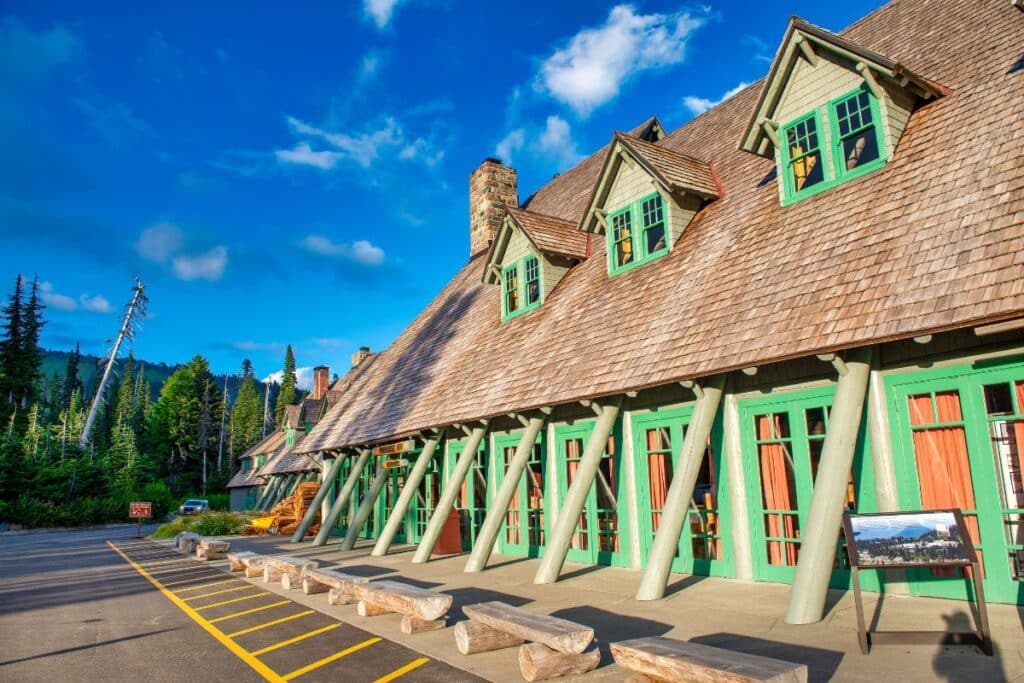

Additionally, these are the best hotel options outside the park:
- Mountain Meadows Inn in Ashford is a small bed and breakfast 45 minutes from Paradise.
- Nisqually Lodge in Ashford is an upgraded hotel 40 minutes from Paradise.
- Cowlitz River Lodge in Packwood is a rustic hotel near restaurants about 15 minutes from Ohanapecosh.
- Packwood Lodge in Packwood is a lodge with hotel rooms and cabins only 10 minutes from Ohanapecosh.
Read More: Best Places to Stay in and Near Mount Rainier
If you’re renting a camper van or prefer to tent camp, there are also several campgrounds inside Mount Rainier National Park:
- Cougar Rock Campground is a reservable campground close to Paradise, open from late May to late September.
- Ohanapecosh Campground is a reservable campground in the Ohanapecosh area, about halfway between Paradise and Sunrise. It is open from late May to late September.
- White River Campground is a first-come, first-served campground in the Sunrise area, open from late June to late September.
- Mowich Lake Campground is a first-come, first-served primitive campground in the Carbon River / Mowich area, open from early July to early October.
How to Get to Mount Rainier National Park
Mount Rainier National Park is about 2 hours away from Seattle and 2.5 hours from Portland. Visitors from outside the Pacific Northwest can fly into either Seattle-Tacoma International Airport (SEA) or Portland International Airport (PDX).
You’ll need a car to get to the park as public transportation is limited. Once inside the park, the best way to get around and see the sights is by car since the park does not offer a shuttle service.
I highly recommend renting a campervan if traveling to multiple Washington national parks. I recently rented from Noma Vans on Outdoorsy, and it made it so easy to see the very best of Washington’s national parks on a road trip!
Read More: 3 Best National Parks in Washington
Here are the approximate driving times from the nearby major cities:
- Seattle to Paradise: 107 miles, 2 hours 30 minutes
- Seattle to Sunrise: 96 miles, 2 hours 15 minutes
- Portland to Paradise: 156 miles, 3 hours
- Portland to Sunrise: 184 miles, 3 hours 45 minutes
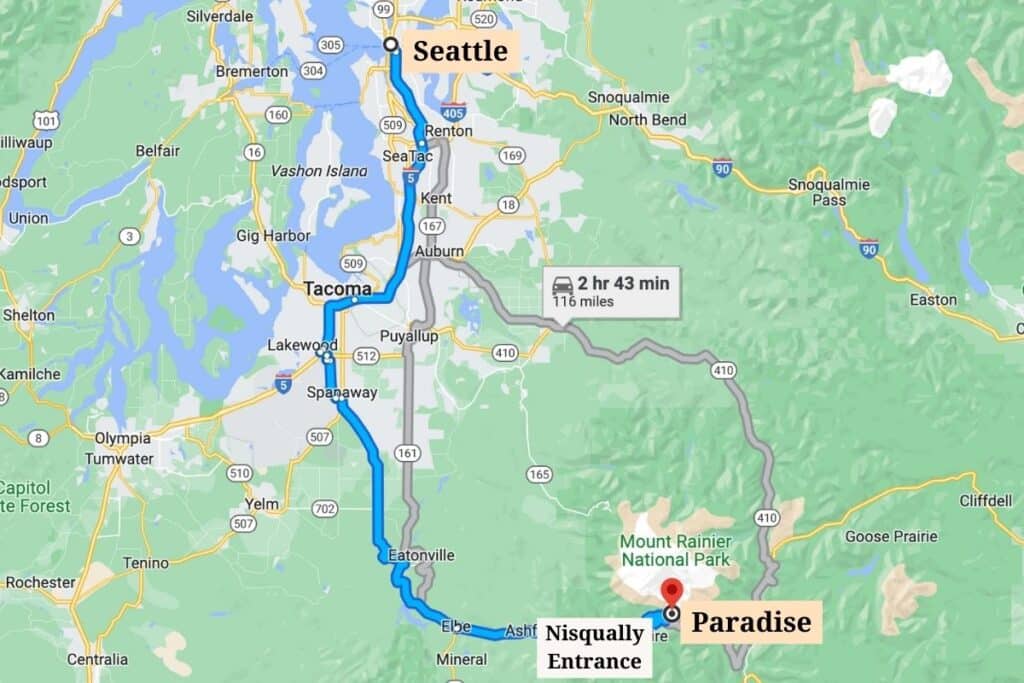

When driving a personal vehicle, you must stop at the Mount Rainier National Park entrance to pay the entrance fee.
You have a couple of options to cover your entrance fee:
- Mount Rainier 7-Day Pass: This can be purchased upon arrival at the entrance station, is valid for seven days, and costs $30.
- America the Beautiful National Park Pass: This can be purchased in advance, is valid for 12 months, and gets you into all 400+ national park sites. If you plan to visit the other Washington national parks on your trip, you’ll save money with the national park pass. Get your national park pass here for only $80.
I use Expedia to find the best flight prices and compare routes. Once you find your flight, you can book directly through Expedia to save money, but still enter your frequent flyer numbers to get points!
If you need a rental car, I also recommend using Expedia to find the best deals across brands like Avis, Hertz, Enterprise, Budget, and more.
Frequently Asked Questions About Things to Do in Mount Rainier
Is Mount Rainier National Park worth visiting?
Mount Rainier National Park is worth visiting. The park offers incredible hiking trails, scenic drives, viewpoints, and opportunities to see wildlife and wildflowers. For the ultimate experience, plan to spend at least two to three days in Mount Rainier National Park.
What is Mount Rainier best known for?
Mount Rainier is best known for being the highest peak in Washington state and the tallest volcanic mountain in the Lower 48 United States. The park is home to 26 glaciers and miles of incredible hiking trails and scenic vistas.
Which side of Mt. Rainier is better?
The south side of Mount Rainier at Paradise is more visited. Still, the northeast side of the mountain in Sunrise is the highest and closest to the towering mountain. Both regions offer incredible views of Mount Rainier.
Final Thoughts on the Best Things to Do in Mount Rainier National Park
There’s no shortage of incredible things to do in Mount Rainier National Park. However, if you’re short on time, I recommend checking this list of activities to prioritize your time in the park.
These are the top 10 things to do in Mount Rainier National Park:
- Skyline Trail (Paradise)
- Reflection Lakes (Paradise)
- Narada Falls (Paradise)
- Grove of the Patriarchs (Ohanapecosh)
- Mount Fremont Lookout (Sunrise)
- Spot Wildflowers (Paradise & Sunrise)
- Myrtle Falls (Paradise)
- Sunrise Point (Sunrise)
- Burroughs Mountain Trail (Sunrise)
- Tipsoo Lake (Sunrise)
Are you looking for more ideas for your Mount Rainier National Park trip? Check out these posts!
- Day Trip Itinerary: How to Spend One Day in Mount Rainier
- Hikes: 25 Best Hikes in Mount Rainier
- Where to Stay: Best Hotels & Campgrounds Near Mount Rainier
- More in Washington: 3 Best National Parks in Washington State
Are you planning a national park trip but don’t know where to start? Get my free 28-page national park ebook where I break down everything you need to know to visit all 63 USA national parks.
Download your free ebook here.
Don’t Forget to Save This Post on Pinterest
